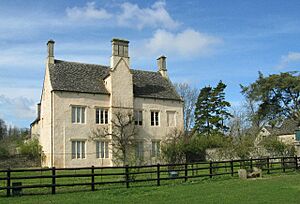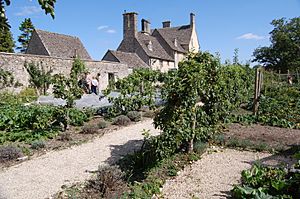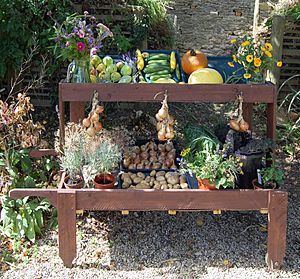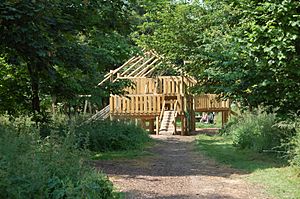Cogges Manor Farm facts for kids

Cogges Manor Farm – the House
|
|
| Established | 1974 |
|---|---|
| Location | Cogges |
| Type | heritage centre |
Cogges Manor Farm is a special place near Witney in Oxfordshire, England. It used to be a real working farm. Now, it's a fun heritage centre where you can learn about farm life. A charity runs it, and it's open for everyone to visit!
Contents
Discover Cogges Manor Farm
Cogges Manor Farm helps visitors understand where their food comes from. You can see how animals are cared for and how plants are grown. They also have workshops for kids and adults. These workshops teach about food, local history, gardening, and old-fashioned crafts.
The farm's old barns and grounds are used for cool events. These include traditional festivals, plays, and private parties. It's also a great place for families to relax. You can meet and feed the farm animals. Enjoy the peaceful farmyard, the fruit orchard, and a traditional vegetable garden. There's even a woodland area with an old moat near the Windrush.
Even though it's close to busy Witney, Cogges Manor Farm feels very rural. It's surrounded by open fields and pastures. The buildings look like those found in the Cotswolds. The farm is also inside the old Royal Hunting Forest of Wychwood.
A Look Back in Time: History of Cogges
The main house at Cogges is a Cotswold stone building. It was first built in the mid-1200s. Back then, it had four parts around a central courtyard. Today, you can still see the 13th-century kitchen and part of the main hall. The dairy building also has parts of another old section. The other two parts of the house are gone, but you can still find traces of their foundations. In the 1200s, the manor also had a large fishpond. However, modern houses now cover part of where the pond used to be.
The manor house was likely built after Walter de Gray, who was the Archbishop of York, bought part of Cogges in 1241. In 1242, people called the house the Archbishop's Court. By 1245, the Archbishop gave Cogges Manor to his nephew, Sir Robert de Grey. The de Grey family owned the house until 1485. Sometimes, the house was used as a special home for widows of the Barons Grey of Rotherfield. This kind of house is called a dower house.
During the 1500s, the manor had several different owners. One owner changed the old hall by adding a second floor and a new, taller roof. The Blake family bought the manor in 1667. They added the second wing that you see today. In 1726, Daniel Blake sold Cogges Manor Farm to Simon Harcourt, 1st Viscount Harcourt. The Harcourt family rented out the farm until 1919. At that time, the Mawle family, who were renting it, bought the farm outright. In 1974, Oxfordshire County Council bought Cogges Manor Farm. They turned the house and farm into a museum.
From Museum to Family Fun
For a while, Cogges Manor Farm was a living museum. It showed what rural life was like in Oxfordshire during the Victorian era. The local council helped pay for it. But on August 31, 2009, the council stopped funding the museum, and it closed. News reports at the time said a new charity planned to reopen it in April 2010.
Cogges Today: Re-opening and New Adventures
In July 2011, Cogges Manor Farm opened its doors again! Now, a charity runs it. They rent the land and buildings from Oxfordshire County Council for a very small fee, like a basket of apples. It's not a traditional museum anymore. Instead, it's a place where families and people can relax, learn, and even help out as volunteers. The goal is to help visitors understand food and how it's produced, both in the past and today.
The farm has changed from a museum to a place for learning and fun. They raise small farm animals like chickens, ducks, pigs, and goats. They use old-fashioned methods. Vegetables are grown for food in a classic 'walled garden'. Volunteers, guided by a small team, have made most of these changes happen.
The idea is that by volunteering, taking courses, and seeing the work, visitors can learn about small-scale farming. They can understand its challenges and rewards. Displays, activities, and guided tours explain how Cogges Manor Farm has grown since Saxon times. You can learn how people who lived there in the past made a living. You'll also see how the farm has changed over time.
The old medieval moated area was once overgrown. Volunteers carefully cleared it. Now, it's a fun place for playing and family trails. These trails connect to the farm's history. The goal is for the farm to become a popular visitor spot that pays for itself. They host events like food markets and a beer festival. These events, along with admission fees, help the farm stay open.
With help from local businesses, the farmyards and barns have been improved. They still keep their old-fashioned feel. The barns are now popular for wedding receptions. These special events help the charity earn money to keep the farm going.
Former UK Prime Minister David Cameron visited the farm in January 2011. He thought the charity's plans were "enterprising." He visited again in September 2013 and praised their success. He returned in July 2015 for celebrations of the 800th anniversary of Magna Carta.
Cogges Manor Farm is also famous for another reason! It's used as the fictional Yew Tree Farm in the popular TV series Downton Abbey.





